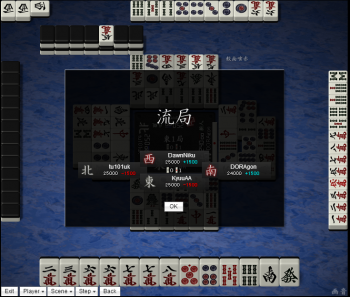Ryūkyoku
Ryūkyoku 「流局」, aussi appelée donne nulle, décrit le cas où toutes les tuiles en dehors du mur mort sont piochées et où aucun joueur ne déclare de main gagnante. Des points sont échangés selon l'avancement des mains de joueurs : tenpai ou noten.
Lorsque cela se produit, les joueurs tenpai peuvent leurs mains et recevoir des points des joueurs noten, bien que cela ne soit pas obligatoire (mais dans ce cas ils sont considérés noten et doivent donc payer).
Un changement des vents peut se produire ou non selon la main du donneur. Si le donneur est tenpai, les vents restent dans le même état pour la prochaine donne ; si par contre il n'est pas tenpai les vents tournent d'une place (il arrive que certaines variantes demandent à ce que le donneur remporte la donne plutôt que se contenter d'être tenpai).
While the term "ryuukyoku" is usually used to refer to an exhaustive draw in Japanese, on occasion this may be ambiguous, as the term technically refers to any draw (cf. tochuu ryuukoku, 「途中流局」). When ambiguity occurs, it may be referred to as tsuujau no ryuukyoku 「通常の流局」, which translates roughly as "usual kind of draw".
Nearly 40% of professional games go to an exhaustive draw due to players immediately abandoning the hand when a player declares riichi.
Tenpai
Tenpai is the state of the hand waiting on just one tile to claim for a win, either by draw or discard. Even if the hand does not win, it can still be awarded a small amount of points at the end of the hand, after all possible tiles are drawn and discarded. So, hands at tenpai during ryuukyoku still has some value.
Point exchanges
If some players are tenpai and some are not, a total exchange of 3,000 points are evenly split between the players in tenpai players from the players in noten.
Point exchanges are as follows:
- 0 players in tenpai: No points exchanged.
- 1 player in tenpai: All players in noten pays 1,000 points to the tenpai player.
- 2 players in tenpai: Each player in noten pays 1,500 points, each player in tenpai receives 1,500 points.
- 3 players in tenpai: The single player in noten plays 1,000 points to each player in tenpai.
- 4 players in tenpai: No points exchanged.
When no players are in tenpai, then the wind seating rotates. When all players are tenpai, then the wind seating does not rotate. For the other three cases, wind rotation is dependent on the dealer being tenpai or not. When a ryuukyoku occurs, a honba is added to the count for the next hand, with two exception: when a player in riichi reveals a noten and is penalized for chombo and, in some variations of the nagashi mangan rule, when a player successfully completes nagashi mangan.
Sometimes, the ryuukyoku point exchanges is enough to determine the final position in games, especially in oorasu (the last hand). Dealers in tight point races need to take particular note about the need to attain tenpai or allow the game to end. It may be desirable to pass on a small winning hand in order to collect the payment from noten players instead.
Hand progression
Often, a hand may end in a draw, where players had declared riichi. Any leftover riichi bets on the table are placed near the counters until collected by the winner of a hand. If the dealer is not in tenpai, then the seat winds rotate normally. If the dealer is in tenpai, the seat winds remain the same for the next hand.
The count for honba keeps track of the number of consecutive hands, by which no one has won a hand. Every time ryuukyou or even tochuu ryuukyoku (abortive draw) occurs, this count increases by one. Barring house rules, the count may or may not increase regarding chombo. When a non-dealer player wins a hand, the count resets back to zero.
Variation
Variation on ryuukyoku stems from the qualification of tenpai. Under some rules and conditions, hands appear to be in tenpai will be declared as noten instead.
Some many consider this hand as noten, despite needing one tile for completion. However, that one tile is one among the tiles called for kan. The hand is also karaten, or impossible to complete. All possible tiles for completion are used with the dubious kan call. So, instead of gaining points, the player loses points at ryuukyoku.
At some point, the hand looked like this. As it stands, this hand is actually complete. The kan was closed, and no open call was made. The tiles already constitute the necessary tile groups and the pair. Therefore, the hand should have been properly called for a win or tsumo instead.
External links
- Ryūkyoku sur la Wikipédia japonaise
[en:Ryuukyoku]]
